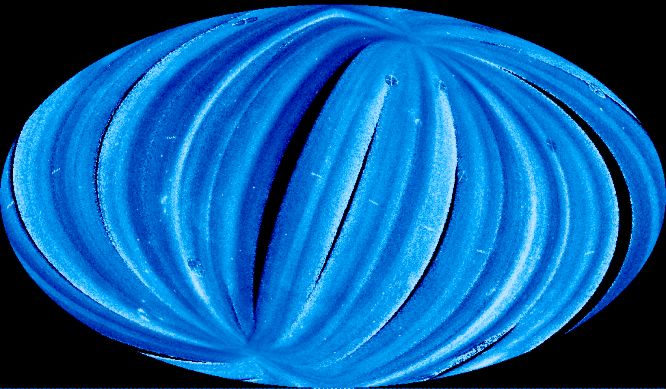Explanation: The stars beyond the Sun and the distant galaxies should be undetectable at extreme ultraviolet wavelengths. At least that was the conventional wisdom when it was first realized that the space between the stars is filled with hydrogen, a strong absorber of extreme ultraviolet light. But this idea was seriously questioned as it became apparent that interstellar hydrogen was patchy in its distribution and the quest to explore the extreme ultraviolet sky culminated in 1992 with the launch of the EUVE (Extreme UltraViolet Explorer) spacecraft. An all-sky map, based on the satellite's first six months of operation, appears above showing brightness variations in the EUV sky in false color (north is up). EUVE's scanning by orbit gives the picture a striped look while other instrument artifacts are seen as crosses and data gaps are dark. Multiple images of the Moon combine to form the short, bright dashed lines wandering along the middle of the picture. The belt stars of the familiar constellation Orion are fairly easy to make out left of picture center. EUVE's science operations ceased in 2001 but it ultimately detected nearly 1,000 celestial objects, including over three dozen outside our own galaxy. EUVE's mission of discovery is now complete, and engineers are predicting the spacecraft will re-enter the Earth's atmosphere by early this morning.
1999 2000 2001 2002 2003 2004 2005 2006 2007 2008 2009 2010 2011 2012 2013 2014 2015 2016 2017 2018 2019 2020 2021 2022 2023 2024 2025 |
Yanvar' Fevral' Mart Aprel' Mai Iyun' Iyul' Avgust Sentyabr' Oktyabr' Noyabr' Dekabr' |
NASA Web Site Statements, Warnings, and Disclaimers
NASA Official: Jay Norris. Specific rights apply.
A service of: LHEA at NASA / GSFC
& Michigan Tech. U.
|
Publikacii s klyuchevymi slovami:
euve - all sky - hydrogen - zhestkii ul'trafiolet
Publikacii so slovami: euve - all sky - hydrogen - zhestkii ul'trafiolet | |
Sm. takzhe:
Vse publikacii na tu zhe temu >> | |
